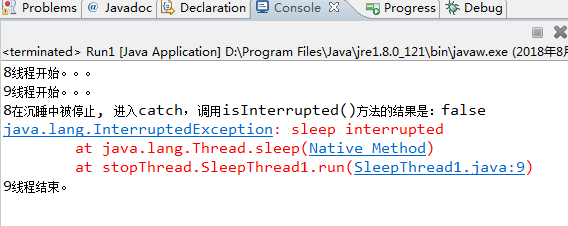停止一个线程意味着在任务处理完任务之前停掉正在做的操作,也就是放弃当前的操作。停止一个线程可以用Thread.stop()方法,但最好不要用它。虽然它确实可以停止一个正在运行的线程,但是这个方法是不安全的,而且是已被废弃的方法。
在java中有以下3种方法可以终止正在运行的线程:
- 使用退出标志,使线程正常退出,也就是当run方法完成后线程终止。(我们什么也不做)
- 使用stop方法强行终止,但是不推荐这个方法,因为stop和suspend及resume一样都是过期作废的方法。(调用stop)
- 使用interrupt方法中断线程:(1:我们自己用interrupted()或isInterrupted()方法判断是否当前线程是否被打了停止标志(调用interrupt方法打标志),如果打了自己new异常对象抛出,即停止了线程;2:interruupt方法打停止标志和sleep结合,先睡再打或者先打再睡都会自动抛出 InterruptedException 异常对象,我们捕获即可。)
1. 停止不了的线程
interrupt()方法的使用效果并不像for+break语句那样,马上就停止循环。调用interrupt方法是在当前线程中打了一个停止标志,并不是真的停止线程。
1 public class MyThread extends Thread { 2 public void run(){ 3 super.run(); 4 for(int i=0; i<500000; i++){ 5 System.out.println("i="+(i+1)); 6 } 7 } 8 } 9 10 public class Run { 11 public static void main(String args[]){ 12 Thread thread = new MyThread(); 13 thread.start(); 14 try { 15 Thread.sleep(2000); 16 thread.interrupt(); 17 } catch (InterruptedException e) { 18 e.printStackTrace(); 19 } 20 } 21 }
输出结果:
... i=499994 i=499995 i=499996 i=499997 i=499998 i=499999 i=500000
从运行结果看调用interrupt方法并没有停止线程。
2. 判断线程是否停止状态
Thread.java类中提供了两种方法:
- this.interrupted(): 测试当前线程是否已经中断;
- this.isInterrupted(): 测试线程是否已经中断;
那么这两个方法有什么图区别呢?
我们先来看看this.interrupted()方法的解释:测试当前线程是否已经中断,当前线程是指运行this.interrupted()方法的线程。
1 public class MyThread extends Thread { 2 public void run(){ 3 super.run(); 4 for(int i=0; i<500000; i++){ 5 i++; 6 // System.out.println("i="+(i+1)); 7 } 8 } 9 } 10 11 public class Run { 12 public static void main(String args[]){ 13 Thread thread = new MyThread(); 14 thread.start(); 15 try { 16 Thread.sleep(2000); 17 thread.interrupt(); 18 19 System.out.println("stop 1??" + thread.interrupted()); 20 System.out.println("stop 2??" + thread.interrupted()); 21 } catch (InterruptedException e) { 22 e.printStackTrace(); 23 } 24 } 25 }
运行结果:
stop 1??false stop 2??false
类Run.java中虽然是在thread对象上调用以下代码:thread.interrupt(), 后面又使用
System.out.println("stop 1??" + thread.interrupted());
System.out.println("stop 2??" + thread.interrupted());
来判断thread对象所代表的线程是否停止,但从控制台打印的结果来看,线程并未停止,这也证明了interrupted()方法的解释,测试当前线程是否已经中断。这个当前线程是main,它从未中断过,所以打印的结果是两个false.
如何使main线程产生中断效果呢?
public class Run2 { public static void main(String args[]){ Thread.currentThread().interrupt(); System.out.println("stop 1??" + Thread.interrupted()); System.out.println("stop 2??" + Thread.interrupted()); System.out.println("End"); } }
运行效果为:
stop 1??true stop 2??false End
方法interrupted()的确判断出当前线程是否是停止状态。但为什么第2个布尔值是false呢? 官方帮助文档中对interrupted方法的解释:
测试当前线程是否已经中断。线程的中断状态由该方法清除。 换句话说,如果连续两次调用该方法,则第二次调用返回false。
下面来看一下isInterrupted()方法。
public class Run3 { public static void main(String args[]){ Thread thread = new MyThread(); thread.start(); thread.interrupt(); System.out.println("stop 1??" + thread.isInterrupted()); System.out.println("stop 2??" + thread.isInterrupted()); } }
运行结果:
stop 1??true stop 2??true
isInterrupted()并不会清除状态,所以打印了两个true。
所以:
this.interrupted():测试当前线程是否已经是中断状态,执行后具有将状态标志位清除为false的功能。
this.isInterrupted():测试线程Thread对象是否已经是中断状态,但不清除状态标志。
3. 能停止的线程--异常法
有了前面学习过的知识点,就可以在线程中用for语句来判断一下线程是否是停止状态,如果是停止状态,则后面的代码不再运行即可:
public class MyThread extends Thread { public void run(){ super.run(); for(int i=0; i<500000; i++){ if(this.interrupted()) { System.out.println("线程已经终止, for循环不再执行"); break; } System.out.println("i="+(i+1)); } } } public class Run { public static void main(String args[]){ Thread thread = new MyThread(); thread.start(); try { Thread.sleep(2000); thread.interrupt(); } catch (InterruptedException e) { e.printStackTrace(); } } }
运行结果:
... i=202053 i=202054 i=202055 i=202056 线程已经终止, for循环不再执行
上面的示例虽然停止了线程,但如果for语句下面还有语句,还是会继续运行的。看下面的例子:
1 public class MyThread extends Thread { 2 public void run(){ 3 super.run(); 4 for(int i=0; i<500000; i++){ 5 if(this.interrupted()) { 6 System.out.println("线程已经终止, for循环不再执行"); 7 break; 8 } 9 System.out.println("i="+(i+1)); 10 } 11 12 System.out.println("这是for循环外面的语句,也会被执行"); 13 } 14 }
使用Run.java执行的结果是:
... i=180136 i=180137 i=180138 i=180139 线程已经终止, for循环不再执行 这是for循环外面的语句,也会被执行
如何解决语句继续运行的问题呢? 看一下更新后的代码:(用了抛异常的方式,当检测到线程被中断(即有中断标志位时)抛异常)
public class MyThread extends Thread { public void run(){ super.run(); try { for(int i=0; i<500000; i++){ if(this.interrupted()) { System.out.println("线程已经终止, for循环不再执行"); throw new InterruptedException(); } System.out.println("i="+(i+1)); } System.out.println("这是for循环外面的语句,也会被执行"); } catch (InterruptedException e) { System.out.println("进入MyThread.java类中的catch了。。。"); e.printStackTrace(); } } }
使用Run.java运行的结果如下:
... i=203798 i=203799 i=203800 线程已经终止, for循环不再执行 进入MyThread.java类中的catch了。。。 java.lang.InterruptedException at thread.MyThread.run(MyThread.java:13)
4. 在沉睡中停止
如果线程在sleep()状态下停止线程,会是什么效果呢?
package stopThread; public class SleepThread1 extends Thread { public void run(){ super.run(); try { System.out.println(this.currentThread().getId() + "线程开始。。。"); Thread.sleep(2000);//睡2000毫秒 System.out.println(this.currentThread().getId() + "线程结束。"); } catch (InterruptedException e) { System.out.println(this.currentThread().getId() +"在沉睡中被停止, 进入catch, 调用isInterrupted()方法的结果是:" + this.isInterrupted()); e.printStackTrace(); } } }
package stopThread; public class Run1 { public static void main(String args[]){ Thread thread1 = new SleepThread1(); Thread thread2 = new SleepThread1(); thread1.start(); thread2.start(); thread1.interrupt(); } }
运行的结果是:

前一个实验是先sleep然后再用interrupt()停止,与之相反的操作在学习过程中也要注意:
public class MyThread extends Thread { public void run(){ super.run(); try { System.out.println("线程开始。。。"); for(int i=0; i<10000; i++){ System.out.println("i=" + i); } Thread.sleep(200000); System.out.println("线程结束。"); } catch (InterruptedException e) { System.out.println("先停止,再遇到sleep,进入catch异常"); e.printStackTrace(); } } } public class Run { public static void main(String args[]){ Thread thread = new MyThread(); thread.start(); thread.interrupt(); } }
运行结果:
i=9998 i=9999 先停止,再遇到sleep,进入catch异常 java.lang.InterruptedException: sleep interrupted at java.lang.Thread.sleep(Native Method) at thread.MyThread.run(MyThread.java:15)
说明:
无论先sleep,后interrupt,还是先interrupt,后sleep,后者运行都会抛出 InterruptedException异常(即停止的线程),我们catch该异常即可。
顺便说一下,上面单独用interrupt是停止不了线程的,是我们自己new了异常对象抛出(我们抛之前还判断了是否有interrupt标志位)才停止的线程
5. 能停止的线程---暴力停止
使用stop()方法停止线程则是非常暴力的。
1 public class MyThread extends Thread { 2 private int i = 0; 3 public void run(){ 4 super.run(); 5 try { 6 while (true){ 7 System.out.println("i=" + i); 8 i++; 9 Thread.sleep(200); 10 } 11 } catch (InterruptedException e) { 12 e.printStackTrace(); 13 } 14 } 15 } 16 17 public class Run { 18 public static void main(String args[]) throws InterruptedException { 19 Thread thread = new MyThread(); 20 thread.start(); 21 Thread.sleep(2000); 22 thread.stop(); 23 } 24 }
运行结果:
i=0 i=1 i=2 i=3 i=4 i=5 i=6 i=7 i=8 i=9 Process finished with exit code 0
6.方法stop()与java.lang.ThreadDeath异常
调用stop()方法时会抛出java.lang.ThreadDeath异常,但是通常情况下,此异常不需要显示地捕捉。
public class MyThread extends Thread { private int i = 0; public void run(){ super.run(); try { this.stop(); } catch (ThreadDeath e) { System.out.println("进入异常catch"); e.printStackTrace(); } } } public class Run { public static void main(String args[]) throws InterruptedException { Thread thread = new MyThread(); thread.start(); } }
stop()方法以及作废,因为如果强制让线程停止有可能使一些清理性的工作得不到完成。另外一个情况就是对锁定的对象进行了解锁,导致数据得不到同步的处理,出现数据不一致的问题。
7. 释放锁的不良后果
使用stop()释放锁将会给数据造成不一致性的结果。如果出现这样的情况,程序处理的数据就有可能遭到破坏,最终导致程序执行的流程错误,一定要特别注意:

1 public class SynchronizedObject { 2 private String name = "a"; 3 private String password = "aa"; 4 5 public synchronized void printString(String name, String password){ 6 try { 7 this.name = name; 8 Thread.sleep(100000); 9 this.password = password; 10 } catch (InterruptedException e) { 11 e.printStackTrace(); 12 } 13 } 14 15 public String getName() { 16 return name; 17 } 18 19 public void setName(String name) { 20 this.name = name; 21 } 22 23 public String getPassword() { 24 return password; 25 } 26 27 public void setPassword(String password) { 28 this.password = password; 29 } 30 } 31 32 public class MyThread extends Thread { 33 private SynchronizedObject synchronizedObject; 34 public MyThread(SynchronizedObject synchronizedObject){ 35 this.synchronizedObject = synchronizedObject; 36 } 37 38 public void run(){ 39 synchronizedObject.printString("b", "bb"); 40 } 41 } 42 43 public class Run { 44 public static void main(String args[]) throws InterruptedException { 45 SynchronizedObject synchronizedObject = new SynchronizedObject(); 46 Thread thread = new MyThread(synchronizedObject); 47 thread.start(); 48 Thread.sleep(500); 49 thread.stop(); 50 System.out.println(synchronizedObject.getName() + " " + synchronizedObject.getPassword()); 51 } 52 }
输出结果:
b aa
由于stop()方法以及在JDK中被标明为“过期/作废”的方法,显然它在功能上具有缺陷,所以不建议在程序张使用stop()方法。
8. 使用return停止线程
将方法interrupt()与return结合使用也能实现停止线程的效果:
1 public class MyThread extends Thread { 2 public void run(){ 3 while (true){ 4 if(this.isInterrupted()){ 5 System.out.println("线程被停止了!"); 6 return; 7 } 8 System.out.println("Time: " + System.currentTimeMillis()); 9 } 10 } 11 } 12 13 public class Run { 14 public static void main(String args[]) throws InterruptedException { 15 Thread thread = new MyThread(); 16 thread.start(); 17 Thread.sleep(2000); 18 thread.interrupt(); 19 } 20 }
输出结果:
... Time: 1467072288503 Time: 1467072288503 Time: 1467072288503 线程被停止了!
不过还是建议使用“抛异常”的方法来实现线程的停止,因为在catch块中还可以将异常向上抛,使线程停止事件得以传播。
参考:
《java多线程编程核心技术》 高洪岩著
https://www.cnblogs.com/greta/p/5624839.html
